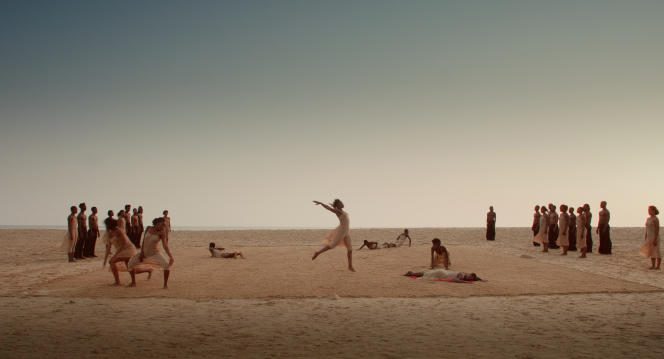THE OPINION OF THE “WORLD” – NOT TO BE MISSED
Dancing Pina adds to an already extensive list of documentaries celebrating the highly cinematic value of the ballets of Pina Bausch (1940-2009): One day Pina asked…by Chantal Akerman (1983); dancing dreams, by Anne Linsel and Rainer Hoffmann (2010) and the 3D experimentation of the very beautiful pinaby Wim Wenders (2011) – not to mention Almodovar’s tribute to him in Speak with her (2002). Characters, dramaturgy, affects: in a single ballet by the choreographer, there is already everything one would expect from a fiction, if not life, but stripped of all the superfluous. The pleasure of seeing his creations on the big screen is perhaps due to the feeling of reconnecting with the most primitive origins of cinema, of enjoying something as simple as the movements of bodies as they are exalted in chronophotographs by Etienne-Jules Marey.
In Dancing Pina, documentary filmmaker Florian Heinzen-Ziob fleshes out this primal enjoyment, by constructing his documentary around a parallel montage, straddling two continents. In Dresden, Germany, behind the scenes of the opera, the Semperoper, a troupe is rehearsing theIphigenia in Taurideballet that Pina Bausch created in 1974. While in Dakar, at the Ecole des Sables, a troupe of young African dancers appropriated her staging of the Rite of Spring (1975). Two troupes linked by the magic of editing, and working under the direction of former members of Pina Bausch’s company who persist in passing on the work of their mentor.
Generous pedagogy
It is here more than the dance that is transmitted, but the idea that all bodies can dance, without forcing themselves to make their anatomical particularities or their experience disappear – far from the usual canons fixed by the classical discipline. Example is taken from Sangeun Lee, an incredibly ethereal Korean dancer, a tall white reed of 1.82 meters, who is entrusted with the character of Iphigenia and who is followed from rehearsals until the first performance. Facing the camera, she talks about her fears when, when she was younger, she thought her career was compromised by her large size. There is this very beautiful scene where Malou Airaudo, former collaborator of Pina Bausch who was able to practice after her pregnancies and until her fifties, invites her to dance ” big ” rather than trying to hide its size.
The editing, straddling two cultures, far from being a pretty artifice exalting the universality of the artist’s work, is intended to be a generous pedagogy, making concrete the differences in interpretation of Pina Bausch’s “text”. On the one hand, the rehearsals of the classical troupe where the insane work gives way to the unreal fluidity of the gestures. On the other hand, in Senegal, the dancers offer a much more muscular and earthy score. We could not better understand the way in which a body tints each gesture with its own culture. However, the two troupes are equal here, united in their effort to decipher a language – that of Pina Bausch – wonderfully extraterrestrial.
You have 1.7% of this article left to read. The following is for subscribers only.
